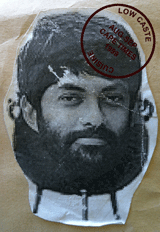
She stepped up to me at the last Cape Times Breakfast Club meeting and patted me on the arm. “When,” she asked, “are you going to do a traditional Indian curry?”
I paused in mid-sip, then looked at her with all seriousness. “Ma’am, I’m afraid you’ve made a mistake. You see, I’m Kanthan Pillay, the Managing Editor of the Cape Times, and I write a column on the leader page every Friday. You’re confusing me with Kanthan Pillay who writes a cooking column for Top of the Times every Friday.”
She looked up at me, puzzled, distressed. I patted her arm reassuringly and whispered to her conspiratorially: “We all look the same.”
She gave a quick smile of relief, nodded understandingly. I managed to keep a straight face as I fled.
As Bugs Bunny would say, ain’t I a stinker?
Actually, this is not a digression, and I wasn’t being deliberately nasty. It’s just so bloody impossible to explain to the most well-meaning and sweet people (and she was that) that there is no such thing as a “traditional Indian curry”.
(Fanfare and trumpets at this point. The world fades into a tropical beachscape painted in sepia tones. Not to worry. It’s just a flashback!)
The SS Truro dropped anchor in Durban in 1860 and discharged her cargo of indentured labourers to work the sugar cane fields because the Zulu people had persistently refused to cooperate with the British by allowing themselves to be conquered. (Damned irresponsible if you ask me — where does that Cetshwayo get off being a military genius anyway? But I digress.…)
Like their Malay and Indonesian counterparts in the Cape, the Indian labour force found themselves having to tweak their cuisine to suit local conditions. They had brought with them some spices and foodstuffs, and some of these —like curry leaves and mango — flourished, but the tropical coconuts had a very stunted time of it in Durban’s sub-tropical climate. So a lot of improvising had to take place rather quickly.
One of the more enduring dishes to emerge from these experiments was the original Durban mutton curry — which cannot be found in India because tomatoes and potatoes are not native to India.
(Natal canefields landscape in sepia tones fades into magnificent vivid colours of the Mother City in the summer. Yes, it’s the flash forward to the present.!)
Today, you can find the original Durban mutton curry along with several other uniquely South African creations at the Talk of the Town restaurant (off Greenmarket Square behind Newspaper House in the centre of Cape Town).
Another dish that you will find on their menu is “tin fish curry”. A basic can of pilchards or salmon popped into a tomato curry base would provide a day’s meal for an entire family on a Saturday night as well as breakfast the following morning. We’re going to cook the same dish, but extravagantly (meaning we’ll feed two and not eight).
Open and drain a can of middlecut. If you’re as finicky as I am, carefully remove and toss the main bones. (Yes, Mrs Jones, you may certainly used a can of salmon for this recipe. In fact, Norwegian salmon is particularly delicious. But stick with the mackerel if you want to go the traditional route.)
In a large deep frying pan over high heat (a wok is good for this) fry one large onion, thinly sliced, in a quarter cup of oil until translucent. Add one or more green chillies sliced once lengthwise. (Do not use more than three chillies unless you’re looking to rent yourself out to NASA as a booster rocket the next day)
Lower the heat. Add a half teaspoon of turmeric powder, a half teaspoon of cumin powder, a half teaspoon of coriander powder, a teaspoon of chilli powder, a centimetre of finely chopped ginger root, and two cloves of crushed garlic. Stir for about a half-minute., then add a half cup of chopped tomatoes (or tomato puree or blended whole peeled tomatoes).
Cook over low heat until the onions have dissolved and the gravy is smooth. Slide the fish carefully into the gravy (do not stir or the fish will dissolve too). Allow to simmer gently for about ten minutes.
If you have garam masala powder, sprinkle on a half teaspoon or so. Garnish with coriander leaves.
If you want to go the full traditional route, serve for Sunday breakfast with thick slices of buttered bread along with cups of strong sweet milky tea (preferably in enamel cups). Then break out the pack of cards and the bottle of Mainstay.